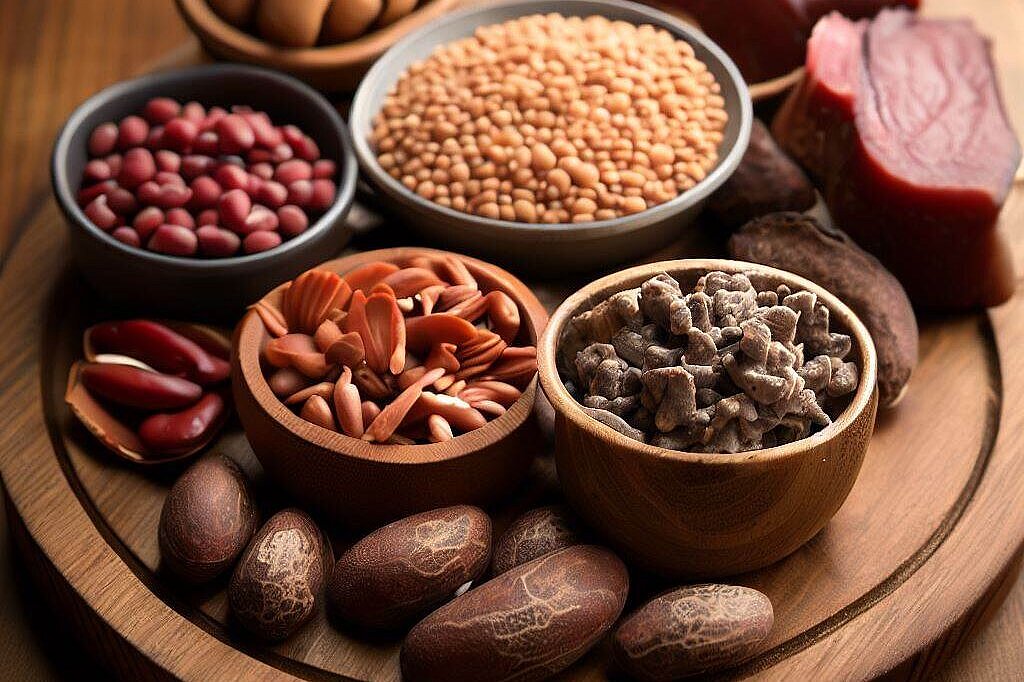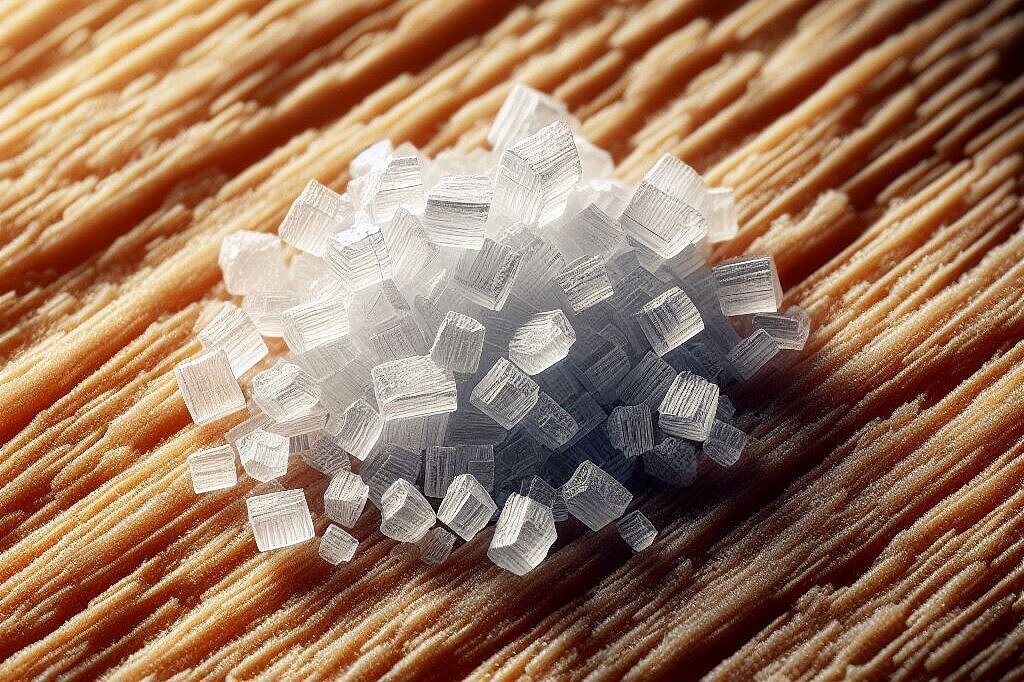Copper

the utilization of oxygen in the cells
the neutralization of free radicals
iron metabolism and blood formation
the synthesis of connective tissue, melanin and neuroactive peptide hormones
Pigmentation of the skin and coat
In this article you can find out more about the function, requirements and sources of copper for your dog.
How much copper does your dog need?
Your dog's copper requirement depends on various factors, such as its age, size, coat type and health. Generally speaking, dogs need about three times the amount of copper that humans need in relation to their energy requirements. This is because dogs have a higher metabolism and need to produce more red blood cells.
The copper requirement of adult dogs is around 0.1 mg per kilogram of body mass per day. The requirement is greater for long-haired dogs during the shedding period. Pregnant bitches require around 0.15 mg per kilogram of body mass per day. The copper requirement for nursing bitches is 0.65 mg and for growing puppies around 0.15 to 0.50 mg per kilogram of body weight.
Where does your dog get copper from?
Copper is found in various foods that you can feed your dog. The most important sources are:
- Liver: Liver is particularly rich in copper and covers your dog's needs with a relatively small amount. Lamb liver has the highest concentration with 7 mg per 100 g, followed by beef liver with 3 mg per 100 g and chicken liver with 0.3 mg per 100 g. However, you should not feed too much liver, as it also contains a lot of vitamin A, which can be harmful in excessive doses. Liver can also contain harmful substances that the animal has absorbed during its lifetime.
- Nuts: Nuts are a plant-based alternative to liver and also contain a lot of copper. Cashew nuts in particular have a high content of 2.1 mg per 100 g. However, nuts also contain phytic acid, which reduces the availability of minerals. Phytic acid binds copper and other minerals such as iron, magnesium, calcium and zinc and makes them unavailable to the body. You should therefore only feed nuts in moderation or soak or ferment them beforehand to reduce phytic acid.
- Ready-made food: If you give your dog ready-made food, you don't have to worry about his copper requirements. Food manufacturers add synthetic copper compounds such as carbonate or gluconate to the food to meet the requirement. However, you should make sure that the food does not contain too much copper, as this can lead to an overload in some dog breeds.
What happens if there is a copper deficiency or overload?
Copper is an essential trace element for your dog, which means that they cannot produce it themselves and have to get it from their food. If he gets too little or too much of it, this can lead to health problems.
A copper deficiency can cause the following symptoms, among others:
- Anemia: Copper is involved in the formation of hemoglobin, the pigment in red blood cells that carries oxygen. If your dog has too little copper, it cannot produce enough haemoglobin and becomes pale and weak.
- Growth disorders: Copper is involved in the synthesis of collagen and elastin, the main components of connective tissue. If your dog has too little copper, it cannot build up enough connective tissue and has problems with its bones, joints and tendons.
- Lightening or greying of the coat: Copper is involved in the formation of melanin, the pigment responsible for the color of the skin and coat. If your dog has too little copper, it cannot produce enough melanin and its coat loses color and shine.
A copper deficiency can have various causes, such as
- an unbalanced meat diet without liver or other copper-rich foods
- a high intake of phytic acid from nuts or cereals, which inhibits the absorption of copper
- a high intake of zinc from food supplements or ready-made food, which inhibits the absorption of copper
- a genetic disorder that impairs the utilization of copper
An overload of copper can also be harmful to your dog. This is because copper is a heavy metal that can accumulate in the body, especially in the liver. If the liver stores too much copper, it can no longer perform its function properly and liver damage occurs.
An overload of copper can have various causes, such as
- too high an intake of liver or other copper-rich foods
- too high an intake of synthetic copper from ready-made food or food supplements
- a genetic disorder that impairs the excretion of copper
Some dog breeds in particular are susceptible to hereditary copper storage disease. These include the Bedlington Terrier, the West Highland White Terrier, the Doberman, the German Shepherd and the Cocker Spaniel. In these breeds, more and more copper is deposited in the liver with increasing age until it leads to severe liver disease.
How can you keep your dog's copper levels in balance?
To provide your dog with an optimal supply of copper and avoid a deficiency or overload, you should follow these tips:
- Feed your dog a balanced diet with a variety of foods that provide him with all the important nutrients.
- Feed your dog liver regularly as a natural source of copper, but not too much to avoid an overdose of vitamin A and contaminants.
- Occasionally feed your dog nuts as a vegetable source of copper, but not too much to avoid inhibiting mineral absorption through phytic acid. Soak or ferment the nuts beforehand to reduce phytic acid.
- Do not feed your dog ready-made food or supplements containing synthetic copper if he is already getting enough from natural sources. Pay attention to the information on the labels and compare it with your dog's requirements.
- Have your dog checked regularly by the vet and have his liver values checked. Especially if you have a dog of a breed at risk
In short, your dog needs an appropriate amount of copper for his health. Too little or too much can cause problems. You can provide your dog with a balanced diet or consult your vet if you are unsure.
If you notice any signs of hypersensitivity or poisoning in your dog, you should see your vet immediately. We are not a substitute for a vet, but we try to be as accurate as possible. Every dog reacts differently and we recommend you get a second opinion or consult your vet if in doubt.
Stay healthy and take good care of your four-legged friend!😊
Similar to Copper
Iron is a chemical element that occurs naturally. It is an important component of hemoglobin, the red blood pigment. Hemoglobin binds oxygen in the lungs and transports it to cells throughout the...
The optimum amount of zinc for your dog depends on various factors, such as his age, size, state of health and diet. The German Nutrition Society (DGE) recommends a daily zinc intake of 2 to 5...
The optimum magnesium intake for dogs depends on various factors, such as your dog's age, weight, activity level and state of health. It is therefore difficult to give a general recommendation....
Selenium is a chemical element that occurs in nature in various forms. There are organic and inorganic selenium compounds, which differ in their bioavailability and effect. Organic selenium...



